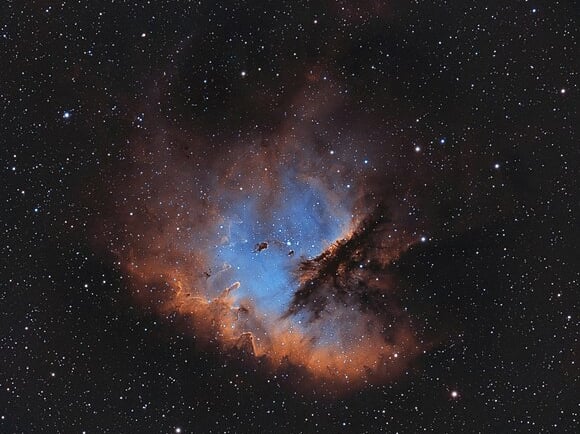NGC 281: The Pacman Nebula


Introduction to NGC 281
NGC 281, popularly known as the Pacman Nebula, is a striking emission nebula located approximately 9,500 light-years from Earth. With a radius extending to 48 light-years, it is part of the Cassiopeia constellation and serves as an intriguing subject for astronomers and enthusiasts alike. This remarkable nebula is notable not only for its distinct appearance but also for its active processes contributing to star formation.
Characteristics of the Pacman Nebula
The NGC 281 nebula presents a vibrant region filled with a rich tapestry of elements essential for the creation of stars. In this stellar nursery, hydrogen gas plays a crucial role, highlighting the nebula's emissions. Its structure is filled with thick, dark dust lanes that add complexity to the beautiful visuals observed through telescopes. These dark patches are indicative of areas where dense concentrations of dust and gas block light, thus providing essential materials for new stars to form.
Star Formation and Bok Globules
Within NGC 281, one can observe several Bok globules, which are small, dense clouds of gas and dust that serve as potential sites for star formation. These globules are fascinating as they often harbor protostars, the earliest stages of star development. The active star-forming region of the Pacman Nebula emphasizes the dynamic nature of our universe; the processes occurring here might yield new celestial bodies in the near future. To the naked eye, NGC 281 might appear as a wispy cloud, but in detailed observations, one can discern the intricate details of its formation process.
The culmination of such astronomical studies of the Pacman Nebula aids our understanding of stellar evolution and the lifecycle of galaxies. Through advanced imaging technology, astronomers can capture breathtaking images, rendering NGC 281 a popular target for both professional and amateur astrophotographers.
In conclusion, NGC 281, the Pacman Nebula, is more than just a stunning visual in the night sky. It represents an active and ongoing cosmic phenomenon that is crucial for understanding how stars and galaxies evolve. As we continue to explore the depths of our universe, nebulae like NGC 281 will remain pivotal in unraveling the mysteries of stellar birth and the dynamic processes that shape our cosmic home.
